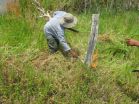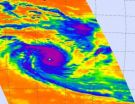(Press-News.org) DETROIT - Both nature and nurture appear to be significant factors in early antisocial behaviors of adopted children, a Wayne State University researcher believes.
Christopher Trentacosta, Ph.D., assistant professor of psychology in the College of Liberal Arts and Sciences, recently examined data from 361 linked triads (birth mother, adoptive parents, adopted child) in order to assess externalizing behavioral problems such as aggression and defiance when children were 18, 27 and 54 months of age.
The triads were part of the Early Growth and Development Study (EGDS), a nationwide, prospective study of birth parents and adoptive families that is supported by grants from the Eunice Kennedy Shriver National Institute of Child Health and Human Development, the National Institute on Drug Abuse and the National Institute of Mental Health — all part of the National Institutes of Health — to Trentacosta's colleagues at the Oregon Social Learning Center and the Pennsylvania State University. The EGDS is aimed at investigating how families can help their children develop to their fullest potential.
In "Examining the Interplay of Birth Mothers' and Adoptive Parents' Antisocial Behavior in Predicting Growth in Externalizing Problems During Early Childhood," adoptive parents' antisocial behavior played an important role in the development of children's externalizing problems. His study was presented at the 2012 meeting of the Behavior Genetics Association in Edinburgh, Scotland.
That finding may not come as a surprise to researchers who have studied environmental precursors to such behavior. However, Trentacosta said a great deal of other research that examined sets of twins holds that genetic factors play a role as well.
Part of the problem with environmental studies, he said, is that the people providing the parenting are the same ones providing the genes. Using an adoption design, Trentacosta said, allows researchers to disentangle genetics from environmental influences by collecting data from both birth and adoptive parents.
His team found that adoptive parents reporting on their own antisocial behaviors predicted children's initial level of externalizing at 18 months, suggesting a direct environmental connection.
"That can be tricky, however, because it is those same parents reporting on the child's behavior," Trentacosta said, "so we aggregated both parents' reports to increase confidence somewhat. But even with the reporting limitation, there is something to be said for the environmental piece, at least initially."
His team's main finding is that there is an interaction between birth mother characteristics and adoptive parent antisocial behavior that is especially problematic for growth in externalizing behavior problems across early childhood.
"Compared to birth mothers with lower levels of antisocial behavior, children of birth mothers with higher levels of antisocial behavior showed steep growth in externalizing problems when raised by adoptive parents with higher levels of antisocial behavior," Trentacosta said. "Both genetic characteristics and environment matter, but it's especially the combination of the two that seems to make a difference over time."
Trentacosta believes further study of the next age group, 54 to 72 months, may help to better determine the most salient predictors of externalizing behavior levels by the time children reach school age.
Previous research has shown that such behaviors typically decrease across the preschool years and as children transition to elementary school. A logical next step, he said, would be to assess behavior levels from the cohort used in his work as the children get older to obtain a more complete picture of how genetic and environmental considerations play out across development.
"Behaviors that start out at fairly normative levels but still more than most can cause problems for children as they get to school age," Trentacosta said. "For prevention purposes, it's helpful if we can identify these children earlier and possibly get extra help for these families."
###
Wayne State University is one of the nation's pre-eminent public research universities in an urban setting. Through its multidisciplinary approach to research and education, and its ongoing collaboration with government, industry and other institutions, the university seeks to enhance economic growth and improve the quality of life in the city of Detroit, state of Michigan and throughout the world. For more information about research at Wayne State University, visit http://www.research.wayne.edu.
END
CHAMPAIGN, Ill. — The small kerosene lamps that light millions of homes in developing countries have a dark side: black carbon – fine particles of soot released into the atmosphere.
New measurements show that kerosene wick lamps release 20 times more black carbon than previously thought, say researchers at the University of Illinois and the University of California, Berkeley. The group published its findings in the journal Environmental Science and Technology.
Black carbon is a hazard for human health and the environment, affecting air quality both indoors and out. ...
Young patients with an aggressive form of leukemia who are likely to relapse after chemotherapy treatment can significantly reduce those odds by receiving additional courses of chemotherapy, suggest the findings of a clinical trial led by investigators at Dana-Farber/Children's Hospital Cancer Center in Boston.
The trial leaders will present the results of the Dana-Farber Cancer Institute ALL Consortium study, which involved nearly 500 patients under age 18 with B-precursor acute lymphoblastic leukemia (B-ALL), at the annual meeting of the American Society of Hematology ...
Over past decades, many areas of the forested Amazon basin have become a patchwork of farms, pastures and second-growth forest as people have moved in and cleared land--but now many are moving out, in search of economic opportunities in newly booming Amazonian cities. The resulting depopulation of rural areas, along with spreading road networks and increased drought are causing more and bigger fires to ravage vast stretches, say researchers in a new study. The study, focusing on the Peruvian Amazon, is the latest to suggest that land-use changes and other factors, including ...
Blood levels of an immunity-related protein, galectin-1, in patients with newly diagnosed Hodgkin lymphoma reflected the extent of their cancer and correlated with other predictors of outcome, scientists reported at the American Society of Hematology annual meeting.
In a study of 315 patients from a German database, researchers from Dana-Farber Cancer Institute found that serum galectin-1 levels "are significantly associated with tumor burden and additional adverse clinical characteristics in newly diagnosed Hodgkin lymphoma (HL) patients."
The measurements were made ...
When it comes to climate change, deforestation and toxic waste, the assumption has been that conservative views on these topics are intractable. But new research from the University of California, Berkeley, suggests that such viewpoints can be changed after all, when the messages about the need to be better stewards of the land are couched in terms of fending off threats to the "purity" and "sanctity" of Earth and our bodies.
A UC Berkeley study has found that while people who identified themselves as conservatives tend to be less concerned about the environment than ...
Violent acts in James Bond films were more than twice as common in Quantum of Solace (2008) than in the original 1962 movie Dr No, researchers from New Zealand's University of Otago have found.
The researchers analysed 22 official franchise films, which span 46 years, to test the hypothesis that popular movies are becoming more violent (The latest Bond film, Skyfall, was not included as it was unreleased at the time of the study).
They found that rates of violence increased significantly over the period studied and there was an even bigger increase in portrayals of ...
Infrared data from NASA's Aqua satellite have watched the strong thunderstorms in Typhoon Bopha fizzle and shrink in area over the weekend as wind shear increased. Bopha has now dissipated in the South China Sea, just west of Luzon, Philippines.
NASA's Aqua satellite has been providing data on Bopha since the day it formed on Nov. 26. In the storm's last days, Aqua's Atmospheric Infrared Sounder (AIRS) instrument captured infrared data of the storm and showed that cloud top temperatures warmed from Dec. 8 through Dec. 9 as cloud heights fell and thunderstorms lost their ...
NASA's Aqua satellite got "eyeballed" from Cyclone Claudia in the Southern Indian Ocean when two instruments captured the storm's eye in infrared and visible light. Satellite data indicates that Claudia's eye is about 10 nautical miles wide.
On Dec. 10 at 0841 UTC (3:41 a.m. EST), NASA's Aqua satellite's Atmospheric Infrared Sounder (AIRS) instrument captured an infrared view of Cyclone Claudia which showed a clear eye surrounded by powerful thunderstorms. The thunderstorms that surrounded the eye were high in the troposphere and cloud top temperatures topped -63 Fahrenheit ...
An experimental drug combination for preventing graft-versus-host disease (GVHD) was not significantly better than the standard regimen on key endpoints, according to a report of a phase 3 trial at the American Society of Hematology annual meeting.
The combination of two immunosuppressive compounds -- tacrolimus plus sirolimus -- did not provide a statistically significant, GVHD-free survival benefit over the long-used standard of care, tacrolimus plus methotrexate, said researchers from Dana-Farber Cancer Institute who led the multi-center trial.
However, there were ...
Public opinion on environmental issues such as climate change, deforestation, and toxic waste seems to fall along increasingly partisan lines. But new research suggests that environmental messages framed in terms of conservative morals — describing environmental stewardship in terms of fending off threats to the "purity" and "sanctity" of Earth and our bodies — may help to narrow the partisan gap.
A study from researchers at UC Berkeley has found that while people who identified themselves as conservatives tend to be less concerned about the environment than their liberal ...



